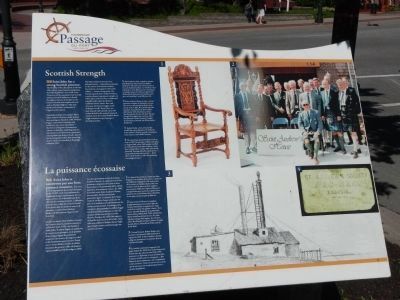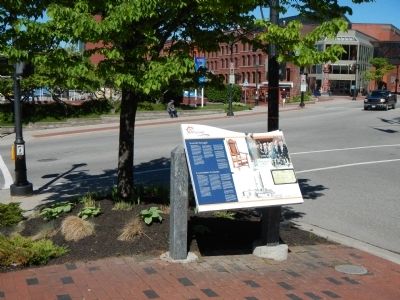Saint John in Saint John County, New Brunswick — The Atlantic Provinces (North America)
Scottish Strength
La puissance écossaise

Photographed By Barry Swackhamer, June 11, 2014
1. Scottish Strength Marker
Captions: English 1) The President’s chair, crafted by member John Rogerson and presented in 1908 to mark the 110th anniversary of the society, is the most cherished artifact. Carved from wood collected in seven different areas of Scotland, it includes a piece of a holly tree planted on Robert Burn’s first grave in Dumfries and a piece of wood that is over 800 years old.; 2) Saint Andrews’s House, a senior citizen’s apartment complex on University Avenue, also serves as the permanent home of the society. Left to right: Rory Grant, Hamish Murdoch, Greg Murdock, Bernie Elliot, Bill Dalziel, Jim Beattie, Dr. John Mackay, George McCaughey, Jim Graham, Douglas Sewell, Murray Driscoll, Ian Whitcomb Jr., Keith Dow.; Robert Foulis, a Scot , invented the world’s first steam fog alarm. In 1928, the Saint Andrew’s Society erected a monument to his memory in Fernhill Cemetery.; 4) The society has sponsored picnics from as early as 1855. The grandest of these took place in August 1866, when 2,500 people travelled by railroad from Saint John to Sussex, where they were joined by another 500. Advertising promised “dancing and other amusements… competitive games and exercises… Every effort will be made to render the gathering exceedingly pleasant.” French 1) Le fauteuil de président, sculpté par John Rogerson, un membre de la société, et présenté en 1908 pour souligner le 110 anniversaire de la société, est l’artéfact le plus cher à ses membres.. Fait de pièces de bois sculptées provenant de différentes régions d’Écosse, it comprend un morceau du houx planté sue la première tombe de Robert Burns à Dumfries et un pièce de bois plus de 800 ans.; 2) Saint Andrew’s House, le complexe d’appartements pour personnes âgées de l’avenue University, est également le siège social de la société. De gauche à droite : Rory Grant, Hamish Murdoch, Greg Murdock, Bernie Elliot, Bill Dalziel, Jim Beattie, Dr. John Mackay, George McCaughey, Jim Graham, Douglas Sewell, Murray Driscoll, Ian Whitcomb Jr., Keith Dow.; 3) C’est un Écossais, Robert Fouis, qui a inventé le tour premier sifflet de brume à vapeur. En 1928, la Saint Andrew’s Society a érigé un monument à sa memoir dans le cimetière Fernhill.; 4) La société commence à organiser des pique-niques dès 1855. Pour le plus important d’entre eux, qui a lieu en août 1866, 2500 personnes se déplacent en train de Saint John à Sussex, où 500 autres les rejoignent. «Des danses, et autres amusements…des compétitions et des exercise… Tout sera mis en oeuvre pour que la rencontre soit un plaisir pour tous», promet la publicité.
Saint John has a strong Scottish presence. The breakup of the clan system in the late 18th century caused massive emigration from the Highlands. As a result, some 25 percent of the population has Scottish ancestry. Scottish influence is found throughout Greater Saint John in the names of streets and neighbourhoods such as MacKay Highway, McLaren Boulevard, ad the community of Upper Loch Lomond.
Saint John is home to Canada’s oldest Saint Andrew’s Society, which held it first meeting on March 8, 1798. William Pagan, a successful merchant and politician was elected president - the first in a long line of prominent citizens at the helm, including mayors, chief justices, and lieutenant-governors. Among them was Robert Foulis, famous for inventing the world’s first steam fog alarm, which was installed at Partridge Island in 1859.
The Saint Andrew’s Society’s two principal tenets - benevolent assistance to the natives of Scotland and their descendants, and support of Scottish culture - remain strong today. The Society opened Saint Andrew’s House, a senior citizens’ apartment complex, in 1992. Saint Andrew’s Day is celebrated annually with a gala that features traditional dress, music, fare, and , of course, the famous haggis , made of sheep’s or calf’s heart, liver, etc., and minced with oatmeal, suet, and onions boiled in the animal’s stomach. And of course the annual Robbie Burns Night continues to pay hommage to Scottish ancestry.
French
Saint John se caractérise par un forte présence écossaise. À la suite de la desagrégation du système clanique, fin du XVIIIᵉ siècle, la population des Highlands emigre massivement. De nos jours, environ 25% des habitants de la ville ont des ancêtres écossais. L’influence écossaise est visible dans tout le Grand Saint John, dans les noms de rues et de quartiers, come route Mackay, boulevard McLaren ou Upper Loch Lomond.
La plus ancienne Saint Andrew’s Society du Canada, dont la première réunion a eu lieu le 8 mars 1798, a été fondée à Saint John. William Pagan, un politicien et commerçant prospère, est la premier d’une longue lignée de présidents comptant de maires, de juges en chef et des lieutenants-gouverneurs. Parmi eux se trouve Robert Foulis, le célèbre inventeur du premier sifflet de brune à vapeur, installé sur l’ile Partridge en 1859.
Les deux principaux credo de la Saint Andrew’s Society, la solidarité envers les personnes originaires d’Écosse et leur descendants et la promotion de la culture écossaise, sont toujours vivaces. En 1992, la société ouvre Saint Andrew’s House, un ensemble d’habitations pour personnes âgées. La journée de la Saint Andrew est fêtée chaque année par un gala où la tradition est représentée par les tenues vestimentaires, la musique, et la cuisine et, bien entendu, le célèbre haggis fait d’abats (foie, poumons et coeur) de mouton ou de veau hachés avec de flocons d’avoine, de suif et des onglons et bouillis dans la panse de la bête. Tout cela sans oublier la Robbie Burns Night qui, chaque année, rend hommage aux ancêtres écossais.
Topics. This historical marker is listed in this topic list: Settlements & Settlers. A significant historical month for this entry is March 1877.
Location. 45° 16.357′ N, 66° 3.761′ W. Marker is in Saint John, New Brunswick, in Saint John County. Marker is at the intersection of Market Square and Water Street, on the right when traveling east on Market Square. Touch for map. Marker is at or near this postal address: 10 Market Square, Saint John NB E2L, Canada. Touch for directions.
Other nearby markers. At least 8 other markers are within walking distance of this marker. A Legacy of Tea | Du thé en héritage (a few steps from this marker); Prince William Street - Before and After the 1877 Fire (within shouting distance of this marker); The Marco Polo (within shouting distance of this marker); Centerbeam Place (within shouting distance of this marker); Saint John 225th Anniversary Clock (within shouting distance of this marker); The Landing of the Loyalists (within shouting distance of this marker); Oland Family Breweries (about 90 meters away, measured in a direct line); Here Stood the House Occupied by Benedict Arnold (about 90 meters away). Touch for a list and map of all markers in Saint John.
Also see . . . http://en.wikipedia.org/wiki/Scottish_Canadian. Scottish Canadians are people of Scottish descent or heritage living in Canada. As the third-largest ethnic group in Canada and among the first to settle in Canada, Scottish people have made a large impact on Canadian culture since colonial times. According to the 2011 Census of Canada, the number of Canadians claiming full or partial Scottish descent is 4,714,970,[1] or 15.10% of the nation's total population. (Submitted on September 25, 2014, by Barry Swackhamer of Brentwood, California.)
Credits. This page was last revised on June 16, 2016. It was originally submitted on September 25, 2014, by Barry Swackhamer of Brentwood, California. This page has been viewed 438 times since then and 10 times this year. Photos: 1, 2. submitted on September 25, 2014, by Barry Swackhamer of Brentwood, California. • Andrew Ruppenstein was the editor who published this page.
